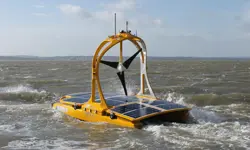
Wayve is scaling self-driving AI around the world
Buckle up: embodied AI is coming. We’re well into the era of conversing with AI through a keyboard and a web browser. Our next stop will see AI physically interacting with the world.
It’ll start in autonomous cars, which will change the way we move around cities, reduce car ownership, and improve road safety. But they’re also a means to hone the intelligence that will ultimately be operating robots in factories and at home. That’s the future according to Alex Kendall, CEO of Wayve, seen as one of the UK’s leading contenders in autonomous driving.
“ChatGPT is changing the world,” says Kendall, “but bringing AI into the physical world in a way that it can interact with us, is real – is tangible. And I think it's going to be the biggest transformation we go through in our lifetimes.”
Wayve sprung out of Kendall’s PhD research at the University of Cambridge in 2017, and what was then a contrarian vision for the future of autonomous driving. At the time, most autonomous driving systems were governed by hard-coded rules and a battery of sensors. Kendall was convinced that the future lay in end-to-end learning: where a single neural network learns from raw data without human intervention.
In 2017, most autonomous driving systems were governed by hard-coded rules and a battery of sensors. Kendall was convinced that the future lay in end-to-end learning: where a single neural network learns from raw data without human intervention.
The belief he’s held for 10 years is looking increasingly prescient. Wayve’s hands-free autonomous cars have now been navigating London’s roads (overseen by legally required safety drivers) since 2020. When Wayve launched in San Francisco at the end of 2024, its AI quickly adapted to drive on the other side of the road. The company has since expanded testing to Stuttgart and Japan, and its fleet has carried Bill Gates, Richard Branson and Microsoft CEO, Satya Nadella.
Now 600 employees strong, Wayve is backed by $1 billion from a 2024 Series C funding round led by Japanese investment group SoftBank, with contributions from NVIDIA and Microsoft – the largest UK deep tech round on record. For his contributions to UK engineering, Kendall will receive the Royal Academy of Engineering’s Princess Royal Silver Medal in July 2025.

Wayve's CEO and Co-Founder, Alex Kendall, is a 2025 winner of the Royal Academy of Engineering’s Princess Royal Silver Medal © Wayve
Rule breakers
During his PhD, Kendall saw that traditional, rule-based autonomous driving systems were expensive and inflexible.
If you picture a robotaxi, you might imagine it parsing its surroundings with roof-mounted LiDAR, plus radar and cameras. Thanks to complicated software based on thousands of rules coded by hand, along with a high-definition map of the area, the car is generally safe to let loose on the road.
Problems arise when the car encounters a new scenario, also called an edge case. Say, in 2023 when an autonomous car got stuck in wet concrete, or earlier this year when a YouTuber set up a fake wall a la Wile E. Coyote.
“The key question is how do you deal with things you haven't seen before?” says Kendall. “How do you have an intelligent system that's general enough to understand those kind of scenarios? And there's no better technology doing that that we know of today than deep learning.”
When Wayve was just getting started, Google DeepMind’s AlphaGo model had not long since defeated a grandmaster in the board game Go, a watershed moment for deep learning. But a Go board is a simplistic environment compared to an autonomous vehicle processing inputs from seven or eight cameras, plus radar and LiDAR sensors. Wayve’s model would have to process tens of millions of numbers, ten times a second.
“We were very scrappy in prototyping what at the time was a real breakthrough in reinforcement learning systems,” Kendall says. Their first demo showed a system that learned to drive in a day, trained on camera footage and occasionally corrected by a safety driver. With less than 40 hours of driving data collected around Cambridge by employees, the model could soon drive around the block and correctly respond to traffic lights.
By 2020, Wayve’s fleet had expanded to London, pretty much no one’s favourite place to drive. With its narrow streets lined with parked cars, potholes, relatively few cycle lanes and pedestrians stepping into the road with little or no warning, Kendall calls the city “one of the hardest driving environments”. Thanks to tackling this chaos, Wayve now has a single AI that can drive different vehicles and operate all around the world.
These days, Wayve’s models are trained on tens of petabytes of data. (By comparison, OpenAI’s GPT-4 model is thought to have been trained on one petabyte of data.) Much of Wayve’s data comes from its team of chauffeurs and the safety drivers. Still more comes from delivery vans operated by partners such as Asda, Ocado and DPD.
This frankly enormous scale is justified by the importance of road safety, explains Kendall. Reliability is the end goal. It may be satisfying to witness a Wayve car handle a challenging negotiation or an emergency safety response, but the pinnacle of excitement for Kendall is a boring drive: a three-hour demo from Wayve’s Sunnyvale office to San Francisco and back, with no human interaction or otherwise remarkable moments.
A jumping-off point for intelligent machines
Even with hundreds of petabytes of real-world data, some road scenarios are too rare or dangerous to record. To plug these gaps, the team built GAIA, a generative AI model that produces synthetic video data simulating moments such as near-collisions, sudden cut-ins or unpredictable pedestrian behaviour.
Wayve has also developed LINGO, a model that interprets language as well as vision. As it drives, it can narrate its driving and answer questions. Wayve started working on it a couple of years before ChatGPT came out, betting that language could be a rich and efficient source of data for models to learn from. It also lets Wayve’s engineers (and eventually passengers) talk to the car and ask it to drive in certain ways or explain its decisions.
“Ultimately, I think the future of robotics is that we're going to want intelligent machines we can delegate tasks to, and to be able to talk to them, to actually instruct them to behave in a way that is safe and matches our preferences,” says Kendall.
This hints at the long-term path for Wayve. Kendall sees driverless cars as a jumping-off point for embodied AI – systems that can physically interact with the world around them. Once proven in autonomous vehicles, he believes embodied AI will expand into manufacturing, healthcare and domestic robots – benefiting from the safety and verification abilities of Wayve’s platform.
Kendall sees driverless cars as a jumping-off point for embodied AI – systems that can physically interact with the world around them. Once proven in autonomous vehicles, he believes embodied AI will expand into manufacturing, healthcare and domestic robots – benefiting from the safety and verification abilities of Wayve’s platform.
All of this might even make it a better driver. “We're seeing as an AI becomes more and more general, it improves the performance,” explains Kendall. “So as our AI learns not just to drive, but to manipulate and to move and understand other objects, I think that'll improve its driving and vice versa.”
Wayve’s plan is to license its technology, first to car companies and then robotics manufacturers. Nissan will be the first taker, with Wayve’s AI due to be landing in its cars in 2027 to support driver assistance.
Tesla, he acknowledges, is one of the few companies building intelligence along with the vehicle. But for other manufacturers and operators, he believes a broad platform is needed. In embodied AI, Kendall believes there will be a trillion-dollar company – and that Wayve could claim that title.
Whatever’s in store, he’s in it for the long haul. “I much more enjoy the problem and the journey,” says Kendall. “The problems are not things that we have an epiphany and solve in one go, it's sustained hard work over, in my case, 10 years, that gets you there.”
Contributors
Florence Downs
Author
Get a free monthly dose of engineering innovation in your inbox
SubscribeRelated content
Technology & robotics

When will cars drive themselves?
There are many claims made about the progress of autonomous vehicles and their imminent arrival on UK roads. What progress has been made and how have measures that have already been implemented increased automation?

Autonomous systems
The Royal Academy of Engineering hosted an event on Innovation in Autonomous Systems, focusing on the potential of autonomous systems to transform industry and business and the evolving relationship between people and technology.

Hydroacoustics
Useful for scientists, search and rescue operations and military forces, the size, range and orientation of an object underneath the surface of the sea can be determined by active and passive sonar devices. Find out how they are used to generate information about underwater objects.

Instilling robots with lifelong learning
In the basement of an ageing red-brick Oxford college, a team of engineers is changing the shape of robot autonomy. Professor Paul Newman FREng explained to Michael Kenward how he came to lead the Oxford Mobile Robotics Group and why the time is right for a revolution in autonomous technologies.
Other content from Ingenia
Quick read

- Environment & sustainability
- Opinion
A young engineer’s perspective on the good, the bad and the ugly of COP27

- Environment & sustainability
- Issue 95
How do we pay for net zero technologies?
Quick read

- Transport
- Mechanical
- How I got here
Electrifying trains and STEMAZING outreach

- Civil & structural
- Environment & sustainability
- Issue 95